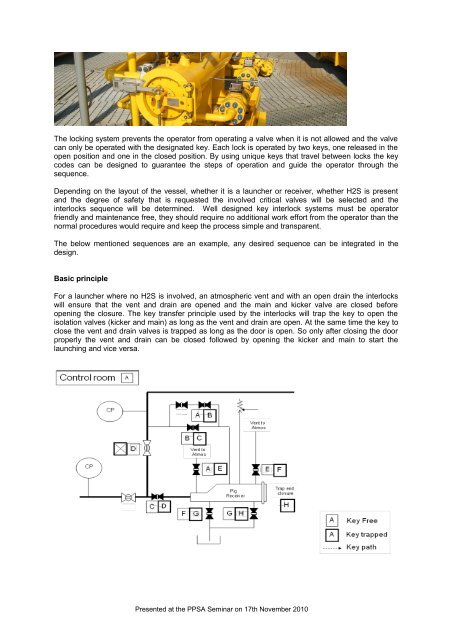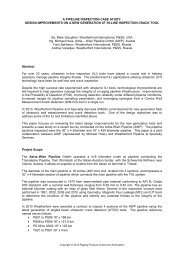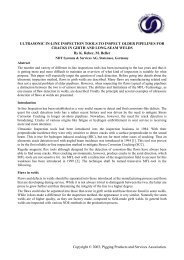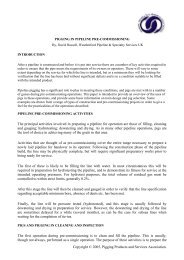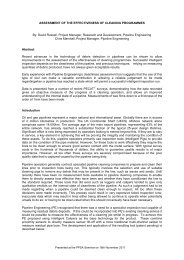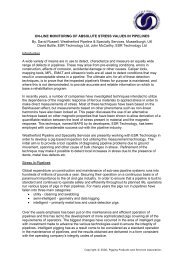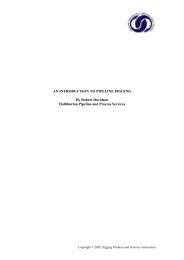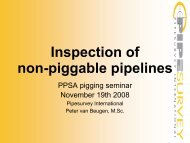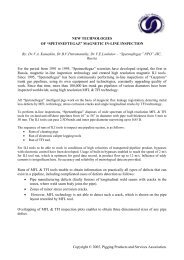safe pigging operation - PPSA, the Pigging Products and Services ...
safe pigging operation - PPSA, the Pigging Products and Services ...
safe pigging operation - PPSA, the Pigging Products and Services ...
You also want an ePaper? Increase the reach of your titles
YUMPU automatically turns print PDFs into web optimized ePapers that Google loves.
The locking system prevents <strong>the</strong> operator from operating a valve when it is not allowed <strong>and</strong> <strong>the</strong> valve<br />
can only be operated with <strong>the</strong> designated key. Each lock is operated by two keys, one released in <strong>the</strong><br />
open position <strong>and</strong> one in <strong>the</strong> closed position. By using unique keys that travel between locks <strong>the</strong> key<br />
codes can be designed to guarantee <strong>the</strong> steps of <strong>operation</strong> <strong>and</strong> guide <strong>the</strong> operator through <strong>the</strong><br />
sequence.<br />
Depending on <strong>the</strong> layout of <strong>the</strong> vessel, whe<strong>the</strong>r it is a launcher or receiver, whe<strong>the</strong>r H2S is present<br />
<strong>and</strong> <strong>the</strong> degree of <strong>safe</strong>ty that is requested <strong>the</strong> involved critical valves will be selected <strong>and</strong> <strong>the</strong><br />
interlocks sequence will be determined. Well designed key interlock systems must be operator<br />
friendly <strong>and</strong> maintenance free, <strong>the</strong>y should require no additional work effort from <strong>the</strong> operator than <strong>the</strong><br />
normal procedures would require <strong>and</strong> keep <strong>the</strong> process simple <strong>and</strong> transparent.<br />
The below mentioned sequences are an example, any desired sequence can be integrated in <strong>the</strong><br />
design.<br />
Basic principle<br />
For a launcher where no H2S is involved, an atmospheric vent <strong>and</strong> with an open drain <strong>the</strong> interlocks<br />
will ensure that <strong>the</strong> vent <strong>and</strong> drain are opened <strong>and</strong> <strong>the</strong> main <strong>and</strong> kicker valve are closed before<br />
opening <strong>the</strong> closure. The key transfer principle used by <strong>the</strong> interlocks will trap <strong>the</strong> key to open <strong>the</strong><br />
isolation valves (kicker <strong>and</strong> main) as long as <strong>the</strong> vent <strong>and</strong> drain are open. At <strong>the</strong> same time <strong>the</strong> key to<br />
close <strong>the</strong> vent <strong>and</strong> drain valves is trapped as long as <strong>the</strong> door is open. So only after closing <strong>the</strong> door<br />
properly <strong>the</strong> vent <strong>and</strong> drain can be closed followed by opening <strong>the</strong> kicker <strong>and</strong> main to start <strong>the</strong><br />
launching <strong>and</strong> vice versa.<br />
Presented at <strong>the</strong> <strong>PPSA</strong> Seminar on 17th November 2010


